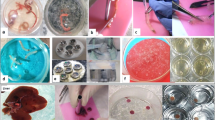Abstract
A NECESSARY preliminary to a study of the physiology of helminths is their maintenance in vitro, a rare accomplishment. Some nematodes and a few cestodes have been maintained for some time with moderate success, and this is also true for certain small trematodes1, but not for Fasciola hepatica. This common liver fluke of the sheep has so far lived in vitro only for short periods of about 60 hr. and never more than about three days. These were the best results of experiments2 in which worms were taken from the livers of cattle or sheep which had been dead for 1–6 hr. and transported from the abattoir to the. laboratory in cold bile. Batches of seven to nine worms wore then immersed in 500 c.c. of various saline solutions and incubated at 37° C, solutions being changed after 16 hr. and after a further 24 hr. In my opinion, an over-elaborato series of experiments failed because the medium (which contained sodium borate) was unsuitable and the trematodes often moribund at the outset. “Many flukes,” we are informed, “never moved in the laboratory except on strong stimulation”, and results were collected on the basis of 50 per cent survival. More satisfactory methods of culture will serve to keep worms alive in a state of active movement, and such worms will retain the reddish colour and fleshy appearance which is normal to them.
This is a preview of subscription content, access via your institution
Access options
Subscribe to this journal
Receive 51 print issues and online access
$199.00 per year
only $3.90 per issue
Buy this article
- Purchase on Springer Link
- Instant access to full article PDF
Prices may be subject to local taxes which are calculated during checkout
Similar content being viewed by others
References
Dawes, B., “The Trematoda” (Camb. Univ. Press, 1946).
Stephenson, W., Parasitology, 38, (3), 116 (1947).
Gatenby, J. B., “Biological Laboratory Technique” (Churchill, 1937).
Van Cleave, H. J., and Williams, C. O., J. Parasit., 29 (1943).
Stephenson, W., Parasitology, 38, (3). 123 (1947).
Author information
Authors and Affiliations
Rights and permissions
About this article
Cite this article
DAWES, B. Maintenance in vitro of Fasciola hepatica . Nature 174, 654–655 (1954). https://doi.org/10.1038/174654a0
Issue Date:
DOI: https://doi.org/10.1038/174654a0
This article is cited by
-
Ionic composition of the liver flukeFasciola hepatica from different mammalian hosts and comparison with host bile
Parasitology Research (1995)
-
Echinostoma trivolvis: Mating behavior of adults raised in hamsters
Parasitology Research (1993)
-
A new method for serodiagnosis of sheep fascioliasis using helminth excretory-secretory products
Parasitology Research (1989)
-
Studies on in vitro survival of Isoparorchis hypselobagri
Zeitschrift f�r Parasitenkunde (1977)
-
Origin, structure and function of subcuticular cells ofFasciola hepatica
Zeitschrift für Parasitenkunde (1976)
Comments
By submitting a comment you agree to abide by our Terms and Community Guidelines. If you find something abusive or that does not comply with our terms or guidelines please flag it as inappropriate.



